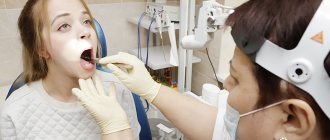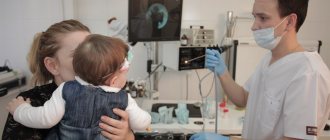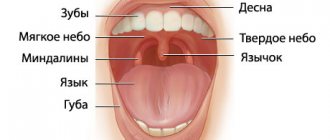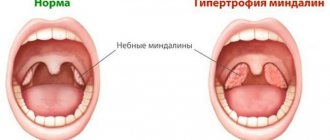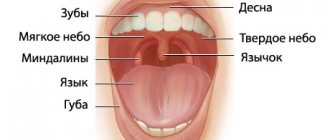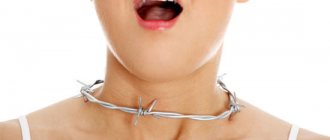Causes and symptoms of the disease
Chronic inflammation of the tonsils can be caused by:
- untreated infectious diseases (most often it is a sore throat, so it is necessary to treat a sore throat in a timely and correct manner);
- the presence of other foci of inflammation in the body (for example, chronic sinusitis);
- diseases of the oral cavity (caries, stomatitis, periodontal disease);
- deviated nasal septum;
- heredity;
- reduced immunity;
- stress and nervous tension.
Any chronic disease is characterized by alternating stages of exacerbation and remission. During an exacerbation, the patient complains of pain, soreness, a feeling of a lump in the throat, as well as bad breath (which indicates the presence of purulent plugs in the lacunae of the tonsils). The body temperature rises to 37.5℃. It is very difficult to stay in this state for a long time. But you still need to study, work, lead a normal lifestyle. Only treatment by an otolaryngologist will help alleviate the patient’s condition and get rid of unpleasant symptoms.
Contraindications to washing with hardware methods
Despite such a positive effect from hardware methods, in some cases this method cannot be used. These include:
- Retinal detachment.
- Hypertension in stage 3 or 2B.
- 1st and third trimester of pregnancy.
- Acute forms of infectious diseases.
- Oncopathology.
- Atherosclerosis of coronary or cerebral vessels.
- Active tuberculosis.
- Disorders of the autonomic nervous system.
- Pathology of the respiratory and cardiovascular systems in the stage of decompensation.
Remove or treat?
Among experienced patients, there are many stories from the series: “Previously, the problem was solved simply - you just need to remove the tonsils, and life will sparkle with bright colors.” Many patients purposefully come to an ENT doctor with a request to get rid of tonsils once and for all. However, many do not understand that by removing such an important organ of the immune system, a person is deprived of a natural barrier against infection. Yes, the problem of tonsillitis will disappear, but other diseases, for example, of the respiratory tract, will take their place. Bacteria and viruses will be able to freely enter the body, causing inflammation of other human organs and systems.
To remove tonsils according to indications, you need:
- often have a sore throat (more than four times a year);
- have a history of peritonsillar abscess;
- have poor rheumatic test scores;
- diagnose complications in your heart, kidneys or joints.
If there are no direct indications for removal, you need to contact an otolaryngologist to prescribe competent complex therapy, which will significantly increase the duration of remission and reduce the number of exacerbations.
One of the most effective procedures for treating tonsillitis, which avoids removal, is washing the palatine tonsils.
Why do you need to rinse your tonsils?
The palatine tonsils are an organ of the human immune system. They are located at the very entrance to the pharynx on both sides. Outwardly, they resemble almonds. This similarity gave this organ its name. The tonsils consist of a large number of winding canals - crypts. On the surface of the tonsils there are small depressions - lacunae. It is in them that tonsillitis plugs accumulate, which are removed by washing.
Our tonsils act like a filter. They filter everything that enters the oral cavity from outside. And if infectious flora gets on the surface of the tonsils, they begin to produce lymphocytes - cells of the immune system that begin to fight the “enemy”.
If the body's defenses are not enough to cope with viruses and bacteria, an inflammatory process (chronic tonsillitis) starts in the palatine tonsils. In the gaps, pathogenic microflora is activated, the remains of bacterial activity and dead leukocytes accumulate. This entire “mixture” is compressed and turns into white-yellow plugs on the tonsils, which are noticeable upon examination and emit an unpleasant odor. These plugs do not allow inflammation to subside, so sanitation of the tonsils is an important part of the treatment of chronic tonsillitis.
Often, rinsing is the only way to preserve the tonsils and avoid their removal.
Benefits of the procedure
There are two ways to rinse the tonsils: using a syringe or using the vacuum method using the Tonzillor apparatus. The ENT doctor decides how to rinse, based on the patient’s condition and his physiological characteristics.
The washing procedure has a number of undeniable advantages:
- persistent therapeutic effect (if you rinse your throat in courses, you can achieve long-term remission, and the symptoms of tonsillitis will not remind you of themselves for a long time);
- During the procedure, antiseptics and local antibacterial drugs are used, which act exclusively on the inflamed area, unlike conventional antibiotics taken orally;
- no allergic reactions;
- Children and pregnant women can wash their tonsils.
How often do rinses need to be done? For long-lasting results, otorhinolaryngologists recommend performing the procedure several times a year.
Friends! Timely and correct treatment will ensure you a speedy recovery!
Before washing your tonsils, you must stop eating at least an hour before visiting the doctor. After the session you need to abstain from food for a couple of hours.
Complex therapy for chronic tonsillitis usually includes ten rinsing sessions, which are carried out daily or every other day.
Contraindications to washing are: cancer, tuberculosis, acute infectious diseases, mental disorders, hypertension.
Regular rinsing allows you to avoid tonsillectomy (surgery to remove tonsils) and significantly increase the period of remission.
Treatment
There are two main methods of treatment: surgical and conservative.
The treatment method is determined by an otorhinolaryngologist, which depends on:
- forms of chronic inflammation;
- frequency of exacerbations;
- the presence or absence of beta-hemolytic streptococcus in the tonsils;
- effectiveness of previous therapy.
Conservative treatment method:
- Local antibiotic therapy
- Systemic antibiotic therapy (tablet or injection forms).
- Rinsing the lacunae of the tonsils and introducing antibacterial and anti-inflammatory drugs into them.
- Physiotherapeutic procedures:
- phonophoresis of drugs,
- ultraviolet radiation (UV),
- magnetic laser therapy (MILTA),
- vibroacoustic impact.
Rinsing the tonsils with a syringe
This method is the most common and accessible. It will be offered to you at the local clinic. The essence of the technique is as follows: an ENT doctor, using a needle-free syringe, injects an antiseptic drug into the lacunae of the tonsils, which, together with the purulent masses from the lacunae, is washed into the patient’s oral cavity. The patient spits the solution into a special tray, and the ENT doctor repeats the procedure. Upon completion, the tonsils are lubricated with Lugol's solution.
The disadvantage of the procedure is that it is not possible to thoroughly rinse the lacunae, since the openings in the tonsils are very narrow. This rinsing helps with minor purulent accumulations.
The manipulation should be carried out by an experienced ENT doctor. Inept movements can injure the walls of the tonsils, which will only worsen the patient’s condition.
Recently, in modern ENT clinics this technique is used less and less, mainly in cases where the patient has a pronounced gag reflex.
It is much more effective to rinse the tonsils using a vacuum method using the Tonsillor apparatus.
How is ENT rinsing of tonsil lacunae done with the “Tonsillor” apparatus?
This procedure involves simultaneous exposure of the affected area to vacuum and ultrasound. The first exerts accentuated mechanical pressure on the tonsils, helping to effectively remove purulent plugs. Ultrasound has an anti-inflammatory and bactericidal effect. In addition, it improves blood supply to the ENT organs and helps to increase the effectiveness of drug therapy, which together accelerates the tissue healing process and the patient’s recovery.
Vacuum washing method
The vacuum method of rinsing using the Tonsillor apparatus is the most modern way to rinse the lacunae of the tonsils.
In simple terms, the nozzle of the Tonsillor device works on the principle of a vacuum cleaner. It is attached to the tonsil, the device creates negative pressure. The washing solution, passing through the lacunae of the tonsils, washes out their pathogenic contents, which, together with the waste solution, are sucked into a special cup of the nozzle. That is, the solution is used and passes through the tonsils only once, which confirms the sterility of the manipulation. Before washing, topical anesthesia of the tonsils is performed with lidocaine solution.
Despite the effectiveness of vacuum washing, this method is not without its drawbacks:
- it happens that the edges of the nozzle can injure the surface of the tonsil;
- The walls of the cup, where the washing solution that has passed through the tonsils is evacuated, is opaque, and the doctor cannot see whether the tonsils have been completely washed. As a result, the ENT doctor has to carry out additional procedures to certainly clear the lacunae.
A reasonable question arises: “Is washing the tonsils always associated with some risks?” No! There is another way to wash the tonsils - safe, effective and non-traumatic. This is the use of an improved Tonsillor attachment.
What is this procedure?
Tonsilor is a special device that came into the arsenal of otorhinolaryngologists several years ago, but has already proven its undeniable effectiveness. The method is based on the vacuum effect on the pathological contents of the lacunae of the tonsils. Tonsilor rinsing can be carried out even in an outpatient clinic; it is enough that the doctor has the necessary equipment and sufficient experience.
To be completely confident in safety and guaranteed results, make an appointment at a diagnostic and treatment center in Moscow. Our specialists will cope with the task quickly and efficiently!
Our clinic constantly hosts promotions
Rinsing with a modified Tonsillor nozzle
This method of washing will not be offered to you in any of the clinics in Moscow, except for the ENT Clinic of Doctor Zaitsev! An improved, modified attachment for the Tonsillor apparatus was developed by the founder of the ENT clinic, Vladimir Mikhailovich Zaitsev, together with his colleagues. The operating principle of the new nozzle is absolutely the same as that of the classic nozzle. The difference is in its structure:
- the improved “Tonsillor” nozzle creates greater negative pressure, due to which rinsing the tonsils is much more effective and of better quality;
- the edges of the nozzle in contact with the tonsils do not cause damage or microtrauma;
- The cup of the nozzle into which the washing solution with the purulent contents of the lacunae is sucked in is transparent, and the doctor immediately sees at what point the procedure can be stopped. Thus, the patient does not undergo unnecessary manipulations.
- The size of the nozzle allows washing even for children.
It is necessary to rinse the tonsils only with the participation of an otolaryngologist. We do not recommend self-medication!
In order to forget about the symptoms of chronic tonsillitis for a long time, it is necessary to undergo a full comprehensive course of treatment of chronic inflammation, including, in addition to rinsing, drug therapy and physiotherapeutic procedures. This is the only way to preserve the tonsils and achieve stable remission!
Flushing with a syringe
This method can be offered in any clinic. It is considered painless and lasts about 10 minutes. The patient is seated and asked to open his mouth. A cannula is attached to the syringe. The surface of the pharynx is treated with a solution of local anesthetic. They do this to reduce discomfort during manipulation.
After this, the cannula of the syringe is inserted into the cavities of the tonsils and their contents are sucked out. This can be pus, microorganisms and their metabolic products, food debris, or liquid. After the procedure, the surface is irrigated with anti-inflammatory solutions.
Why are purulent plugs in the throat dangerous?
If traffic jams and inflammation are not eliminated, the disease can affect the heart and kidneys. Inflammation can affect joints and skin. When pyogenic bacteria penetrate from the throat into the blood, it can become infected and spread the infection to other tissues and organs. There are also known cases of replacement of lymphatic tissues in the palatine tonsils with scar tissue.
Common complications are neck cellulitis and peritonsillar abscess. In the first case, infectious inflammation of the subcutaneous tissue of the neck occurs and, in the absence of surgical treatment, there is a high probability of death. In the second case, the inflammation spreads to the fiber surrounding the tonsils and causes an acute inflammatory process.
What are tonsils, structural features
The immune system consists of many components. They participate in the formation of the body’s immune response to pathogenic agents when attempting to introduce them. The tonsils are considered an important part of it. They are accumulations of lymphoid tissue. The tonsils are located in the mucous membrane lining the pharynx. Formations become the first filter on the path of infection into the body.
Together with other accumulations of lymphoid tissue, they form the pharyngeal ring. Tonsils have a complex structure. They are pierced by winding deep channels called crypts. Branching reaches the third or even fourth order. Their number is usually from 16 to 18 pieces. The epithelium covering the walls of the crypts is associated with lymphoid tissue over a large area.
These formations are most developed in the area of the upper pole of the tonsil. In their lumen, desquamated epithelial cells, food debris, leukocytes, and lymphocytes accumulate. Bacteria actively multiply in this environment. This structure promotes the development of chronic inflammatory processes inside the crypts.
How to get to the procedure
To sign up for lavage of lacunae, you first need to undergo a high-quality examination, which can only be carried out by an experienced ENT specialist:
- visual inspection of the tonsils;
— collection of information about the course of the disease;
- tests;
Only after taking these necessary measures does the doctor decide whether the patient needs this medical procedure, since it has contraindications.
Where to get tonsil treatment
The Elena Malysheva Medical Center offers washing of the lacunae of the palatine tonsils, the cost of the service will not hit your pocket.
Doctors with high qualifications and extensive experience will conduct all the necessary studies before and after the procedures. They will determine whether the patient has contraindications and prescribe the required number of rinses to achieve the maximum therapeutic effect.
All manipulations with the tonsils occur only with the help of the most modern equipment that meets all international quality standards.
If you choose the Elena Malysheva Medical Center, then you are turning to real professionals.
What to do if your throat constantly hurts? Is this an infection?
No, persistent sore throat is most often caused by non-infectious causes. The most common cause is acid from the stomach entering the back of the throat through the esophagus. This condition is medically called gastroesophageal, or extraesophageal, reflux. This is a very common illness that can occur without abdominal pain or heartburn. If heartburn occurs constantly and your throat often hurts, then the connection between these events is obvious and you need to deal with this particular problem, and not try to cure your throat.



